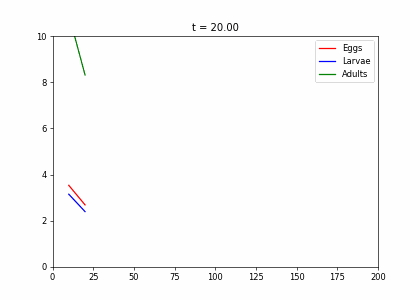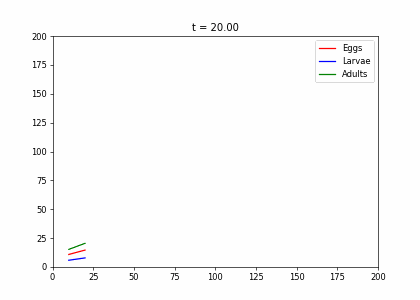class InsectEvolution(BaseStateSystem):
def __init__(self,transition_matrix=np.array([[.2,0,.25],[.6,.3,0],[0,.6,.8]]),max_y=10):
self.steps = 10;
self.t=0
self.transition_matrix = transition_matrix
self.max_y=max_y
def initialise(self):
self.x = np.array([6,8,10])
self.Ya = []
self.Yb = []
self.Yc = []
self.X = []
def update(self):
for _ in range(self.steps):
self.t += 1
self._update()
def _update(self):
self.x = self.transition_matrix.dot(self.x)
def draw(self, ax):
ax.clear()
self.X.append(self.t)
self.Ya.append(self.x[0])
self.Yb.append(self.x[1])
self.Yc.append([self.x[2]])
ax.plot(self.X,self.Ya, color="r", label="Eggs")
ax.plot(self.X,self.Yb, color="b", label="Larvae")
ax.plot(self.X,self.Yc, color="g", label="Adults")
ax.legend()
ax.set_ylim(0,self.max_y)
ax.set_xlim(0,200)
ax.set_title("t = {:.2f}".format(self.t))Ch2 Lecture 2
Discrete Dynamical Systems
Definitions
Definition: A discrete linear dynamical system is a sequence of vectors \(\mathbf{x}^{(k)}, k=0,1, \ldots\), called states, which is defined by an initial vector \(\mathbf{x}^{(0)}\) and by the rule
\[ \mathbf{x}^{(k+1)}=A \mathbf{x}^{(k)}+\mathbf{b}_{k}, \quad k=0,1, \ldots \]
. . .
\(A\) is a fixed square matrix, called the transition matrix of the system
vectors \(\mathbf{b}_{k}, k=0,1, \ldots\) are called the input vectors of the system.
If we don’t specify input vectors, assume that \(\mathbf{b}_{k}=\mathbf{0}\) for all \(k\). Then call the system a homogeneous dynamical system.
Stability
An important question: is the system stable?
Does \(\mathbf{x}^{(k)}\) tend towards a constant state \(\mathrm{x}\)?
. . .
If system is homogeneous, then if a stable state is the initial state, it will equal all subsequent states.
Definition: A vector \(\mathbf{x}\) satisfying \(\mathbf{x}=A \mathbf{x}\), for a square matrix \(A\), is called a stationary vector for \(A\).
. . .
If \(A\) is the transition matrix for a homogeneous discrete dynamical system, we also call such a vector a stationary state.
Example
- Two toothpaste companies compete for customers in a fixed market
- Each customer uses either Brand A or Brand B.
- Buying habits. In each quarter:
- \(30 \%\) of A users will switch to B, while the rest stay with A.
- \(40 \%\) of B users will switch to A , while the the rest stay with B.
- This is an example of a Markov chain model.
Let \(a_1\) be the fraction of customers using Brand A at the end of the first quarter, and \(b_1\) be the fraction using Brand B.
Then we have the following system of equations: \[ \begin{aligned} a_{1} & =0.7 a_{0}+0.4 b_{0} \\ b_{1} & =0.3 a_{0}+0.6 b_{0} \end{aligned} \]
. . .
More generally,
\[ \begin{aligned} a_{k+1} & =0.7 a_{k}+0.4 b_{k} \\ b_{k+1} & =0.3 a_{k}+0.6 b_{k} . \end{aligned} \]
. . .
In matrix form,
\[ \mathbf{x}^{(k)}=\left[\begin{array}{c} a_{k} \\ b_{k} \end{array}\right] \text { and } A=\left[\begin{array}{ll} 0.7 & 0.4 \\ 0.3 & 0.6 \end{array}\right] \]
with
\[ \mathbf{x}^{(k+1)}=A \mathbf{x}^{(k)} \]
We can continue into future quarters by multiplying by \(A\) again: \[ \mathbf{x}^{(2)}=A \mathbf{x}^{(1)}=A \cdot\left(A \mathbf{x}^{(0)}\right)=A^{2} \mathbf{x}^{(0)} \]
. . .
In general,
\[ \mathbf{x}^{(k)}=A \mathbf{x}^{(k-1)}=A^{2} \mathbf{x}^{(k-2)}=\cdots=A^{k} \mathbf{x}^{(0)} . \]
. . .
This is true of any homogeneous linear dynamical system!
For any positive integer \(k\) and discrete dynamical system with transition matrix \(A\) and initial state \(\mathbf{x}^{(0)}\), the \(k\)-th state is given by
\[ \mathbf{x}^{(k)}=A^{k} \mathbf{x}^{(0)} \]
Distribution vector and stochastic matrix
- \(\mathbf{x}^{(k)}\) of the toothpaste example are column vectors with nonnegative coordinates that sum to 1.
- Such vectors are called distribution vectors.
- Also, each of the columns the matrix \(A\) is a distribution vector.
- A square matrix \(A\) whose columns are distribution vectors is called a stochastic matrix.
Markov Chain definition
A Markov chain is a discrete dynamical system whose initial state \(\mathbf{x}^{(0)}\) is a distribution vector and whose transition matrix \(A\) is stochastic, i.e., each column of \(A\) is a distribution vector.
Checking that our toothpase example is a Markov chain
\[ \mathbf{x}^{(k)}=\left[\begin{array}{c} a_{k} \\ b_{k} \end{array}\right] \text { and } A=\left[\begin{array}{ll} 0.7 & 0.4 \\ 0.3 & 0.6 \end{array}\right] \]
Stochastic Matrix Inequality
- We can define the 1-norm of a vector \(\mathbf{x}\) as \(\|\mathbf{x}\|_{1}=\sum_{i=1}^{n}\left|x_{i}\right|\).
- If all the elements of a vector are nonnegative, then \(\|\mathbf{x}\|_{1}\) is the sum of the elements.
- Can show: For any stochastic matrix \(P\) and compatible vector \(\mathbf{x},\|P \mathbf{x}\|_{1} \leq\|\mathbf{x}\|_{1}\), with equality if the coordinates of \(\mathbf{x}\) are all nonnegative.
- → if a state in a Markov chain is a distribution vector (nonnegative entries and sums to 1), then the sum of the coordinates of the next state will also sum to one
- → all subsequent states in a Markov chain are themselves Markov Chain State distribution vectors.
Moving into the future
Suppose that initially Brand A has all the customers (i.e., Brand B is just entering the market). What are the market shares 2 quarters later? 20 quarters?
. . .
- Initial state vector is \(\mathbf{x}^{(0)}=(1,0)\).
- Now do the arithmetic to find \(\mathbf{x}^{(2)}\) : . . . \[ \begin{aligned} {\left[\begin{array}{l} a_{2} \\ b_{2} \end{array}\right] } & =\mathbf{x}^{(2)}=A^{2} \mathbf{x}^{(0)}=\left[\begin{array}{ll} 0.7 & 0.4 \\ 0.3 & 0.6 \end{array}\right]\left(\left[\begin{array}{ll} 0.7 & 0.4 \\ 0.3 & 0.6 \end{array}\right]\left[\begin{array}{l} 1 \\ 0 \end{array}\right]\right) \\ & =\left[\begin{array}{ll} 0.7 & 0.4 \\ 0.3 & 0.6 \end{array}\right]\left[\begin{array}{l} 0.7 \\ 0.3 \end{array}\right]=\left[\begin{array}{l} .61 \\ .39 \end{array}\right] . \end{aligned} \]
Toothpaste after many quarters
Now:
- find the state after 2 quarters.
- find the state after 20 quarters. Use matrix exponentiation: A**n
- Get specific numbers if toothpaste A has 100% of the market at the beginning. (Use sym.subs())
- Now what if toothpaste B has 100% at the beginning?
Example: Structured Population Model
- Every week, 20% of the eggs die, and 60% move to the larva stage.
- Also, 10% of larvae die, 60% become adults
- 20% of adults die. Each adult produces 0.25 eggs.
- Initially we have 10k adults, 8k larvae, 6k eggs. How does the population evolve over time?
. . .
t1=np.array([[.2,0,.25],[.6,.3,0],[0,.6,.8]])
dying_insects = InsectEvolution(t1)
dying_insects.plot_time_evolution("insects.gif"). . .
t2=np.array([[.4,0,.45],[.5,.1,0],[0,.6,.8]])
living_insects = InsectEvolution(t2,200)
living_insects.plot_time_evolution("insects2.gif")Graphs and Directed Graphs
Graph
A graph is a set \(V\) of vertices (or nodes), together with a set or list \(E\) of unordered pairs with coordinates in \(V\), called edges.
Digraph
A directed graph (or “digraph”) has directed edges.
Walks
A walk is a sequence of edges \(\left\{v_{0}, v_{1}\right\},\left\{v_{1}, v_{2}\right\}, \ldots,\left\{v_{m-1}, v_{m}\right\}\) that goes from vertex \(v_{0}\) to vertex \(v_{m}\).
The length of the walk is \(m\).
. . .
A directed walk is a sequence of directed edges.
Winning and losing
Suppose this represents wins and losses by different teams. How can we rank the teams?
Power
Vertex power: the number of walks of length 1 or 2 originating from a vertex.
. . .
Makes most sense for graphs which don’t have any self-loops and at most one edge between nodes. These are called dominance directed graphs
. . .
How can we compute the number of walks for a given graph?
Adjacency matrix
Adjacency matrix: A square matrix whose \((i, j)\) th entry is the number of edges going from vertex \(i\) to vertex \(j\)
- Edges in non-directed graphs appear twice (at (i,j) and at (j,i))
- Edges in digraphs appear only once
. . .
What is the adjacency matrix for this graph?
. . .
\[ B=\left[\begin{array}{llllll} 0 & 1 & 0 & 1 & 0 & 1 \\ 1 & 0 & 1 & 0 & 0 & 1 \\ 0 & 1 & 0 & 0 & 1 & 0 \\ 1 & 0 & 0 & 0 & 0 & 1 \\ 0 & 0 & 1 & 0 & 0 & 1 \\ 1 & 1 & 0 & 1 & 1 & 0 \end{array}\right] \]
What is the adjacency matrix for this graph?
. . .
\[ A=\left[\begin{array}{llllll} 0 & 1 & 0 & 1 & 0 & 0 \\ 0 & 0 & 1 & 0 & 0 & 0 \\ 1 & 0 & 0 & 1 & 0 & 1 \\ 0 & 1 & 0 & 0 & 1 & 0 \\ 0 & 0 & 0 & 0 & 0 & 1 \\ 0 & 0 & 0 & 0 & 0 & 0 \end{array}\right] \]
Computing power from an adjacencty matrix
\[ A=\left[\begin{array}{llllll} 0 & 1 & 0 & 1 & 0 & 0 \\ 0 & 0 & 1 & 0 & 0 & 0 \\ 1 & 0 & 0 & 1 & 0 & 1 \\ 0 & 1 & 0 & 0 & 1 & 0 \\ 0 & 0 & 0 & 0 & 0 & 1 \\ 0 & 0 & 0 & 0 & 0 & 0 \end{array}\right] \]
How can we count the walks of length 1 emanating from vertex \(i\)?
. . .
Answer: Add up the elements of the \(i\) th row of \(A\).
\[ A=\left[\begin{array}{llllll} 0 & 1 & 0 & 1 & 0 & 0 \\ 0 & 0 & 1 & 0 & 0 & 0 \\ 1 & 0 & 0 & 1 & 0 & 1 \\ 0 & 1 & 0 & 0 & 1 & 0 \\ 0 & 0 & 0 & 0 & 0 & 1 \\ 0 & 0 & 0 & 0 & 0 & 0 \end{array}\right] \]
What about walks of length 2?
. . .
Start by finding number of walks of length 2 from vertex i to vertex j.
. . .
\[ a_{i 1} a_{1 j}+a_{i 2} a_{2 j}+\cdots+a_{i n} a_{n j} . \]
. . .
This is just the \((i, j)\) th entry of the matrix \(A^{2}\).
Adjacency matrix and power
Result: The \((i, j)\) th entry of \(A^{r}\) gives the number of (directed) walks of length \(r\) starting at vertex \(i\) and ending at vertex \(j\).
. . .
Therefore: power of the \(i\) th vertex is the sum of all entries in the \(i\) th row of the matrix \(A+A^{2}\).
Vertex power in our teams example
\[ A+A^{2}=\left[\begin{array}{llllll} 0 & 1 & 0 & 1 & 0 & 0 \\ 0 & 0 & 1 & 0 & 0 & 0 \\ 1 & 0 & 0 & 1 & 0 & 1 \\ 0 & 1 & 0 & 0 & 1 & 0 \\ 0 & 0 & 0 & 0 & 0 & 1 \\ 0 & 0 & 0 & 0 & 0 & 0 \end{array}\right]+\left[\begin{array}{llllll} 0 & 1 & 0 & 1 & 0 & 0 \\ 0 & 0 & 1 & 0 & 0 & 0 \\ 1 & 0 & 0 & 1 & 0 & 1 \\ 0 & 1 & 0 & 0 & 1 & 0 \\ 0 & 0 & 0 & 0 & 0 & 1 \\ 0 & 0 & 0 & 0 & 0 & 0 \end{array}\right] \left[\begin{array}{llllll} 0 & 1 & 0 & 1 & 0 & 0 \\ 0 & 0 & 1 & 0 & 0 & 0 \\ 1 & 0 & 0 & 1 & 0 & 1 \\ 0 & 1 & 0 & 0 & 1 & 0 \\ 0 & 0 & 0 & 0 & 0 & 1 \\ 0 & 0 & 0 & 0 & 0 & 0 \end{array}\right] \]
\[=\left[\begin{array}{llllll} 0 & 2 & 1 & 1 & 1 & 0 \\ 1 & 0 & 1 & 1 & 0 & 1 \\ 1 & 2 & 0 & 2 & 1 & 1 \\ 0 & 1 & 1 & 0 & 1 & 1 \\ 0 & 0 & 0 & 0 & 0 & 1 \\ 0 & 0 & 0 & 0 & 0 & 0 \end{array}\right] . \]
. . .
The sum of each row gives the vertex power.
Now you try
Working together,
- pick a topic (sports? elections?).
- Look up data and make a graph or digraph.
- Compute the adjacency matrix.
- Find the vertex powers.
Do your results make sense in context?
Does it make sense?




